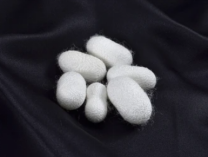
Lifeasible's research team has experimented with different polymer blends with silk fibroin to produce multi-component nanofiber materials. These fibers often combine the advantages of each component and surpass the single-component fibers in terms of properties and functions. It is mainly reflected in the following:
1. The hybrid components not only have the structural integration and mechanical plasticity of some elements, but also have the biological activity of related components, thus increasing their bodily functions.
2. Due to the nature of silk fibroin being difficult to electrospinning, blending mode can significantly increase its spinnability to prepare a novel nanofiber structure.
3. Multi-component nanofibers play a key role in protecting the active groups of factors and controlling the release rate in the multi-factor controlled release process.
Nanofibrous materials prepared from silk fibroin and synthetic polymers are prepared by combining multiple components with the excellent mechanical properties of synthetic polymers and the biological activity of silk fibroin. The following content is a service for the blending of silk fibroin with synthetic polymers.
Poly (ε-caprolactone) is a biodegradable aliphatic polymer with good mechanical properties that are widely used in the preparation of tissue engineering scaffold materials. PCL is an inert biomaterial that lacks natural cell recognition sites for cell adhesion. PCL is blended with biopolymers to improve cell adhesion and viability. By blending silk fibroin with PCL, intermolecular bonds are formed between silk fibroin and PCL. Hydrogen bonds are formed between the amino and carboxyl groups of silk fibroin and PCL, which can improve the mechanical properties of the blends.
Polyurethane has biocompatible, tough, and biologically stable mechanical properties. We can provide a blending service of silk fibroin and thermoplastic polyurethane to obtain a hybrid fiber structure. In addition, the silk fibroin powder can be dispersed into an aqueous polyurethane matrix, resulting in a silk fibroin-polyurethane blend with hydrogen bonding, which increases Young's modulus, tensile strength, and elongation at break as the silk fibroin content increases.
Polyvinyl alcohol (PVA) is a low-cost, biocompatible, available hydrophilic synthetic elastomeric polymer blended with silk fibroin to obtain desired physical and mechanical properties in biological conditions. The mechanical properties such as compressive strength, elasticity, and flexibility are improved due to the interaction of silk fibroin molecules with PVA.
Silk fibroin can also be blended with polylactic acid (PLA) and polyglycolic acid (PGA) to enhance the tensile strength and elongation at the break of the material.
In addition to the above synthetic polymers, it can also be blended with PEG-4000, poly (N-isopropyl acrylamide), poly (ethylene oxide), etc., to modulate different properties and functions.
A differential scanning calorimeter is used to test the thermomechanical properties of the specimens.
The specimens are tested by a universal testing machine for static mechanical properties. The test is conducted in a constant temperature and humidity laboratory, and five parallel experiments are performed on each group of specimens.
In addition to the above product tests, other tests can be found in Blended with Natural Polymers. If you are interested in our services, please feel free to contact us, and we will provide you with a customized solution.
Lifeasible has established a one-stop service platform for plants. In addition to obtaining customized solutions for plant genetic engineering, customers can also conduct follow-up analysis and research on plants through our analysis platform. The analytical services we provide include but are not limited to the following:
STU-CRISPR System Improves Plant Genome Editing Efficiency
April 19, 2024
Application of Exosomes in Facial Beauty
April 12, 2024